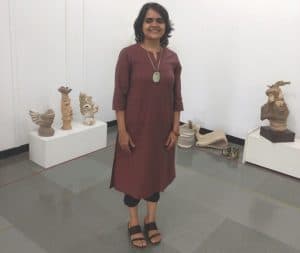The idea took shape during one of Madhavi’s snorkelling trips. “I saw the movement of corals on the seabed. Later, I came to know that they were dying due to environmental pollution. I was struck by their beauty and was pained at their misfortune. I try to immortalise them through my art,” she says.
What she saw and heard about the corals inspired Madhavi to sculpt and draw coral shapes using “coil technique” (where oil is used on ceramics), a technique that she has developed over the last 15 years. “This further triggered my interest in the environment and I started a series of drawings and sculptures on environmental elements,” she adds.
Another series of her paintings are on dried leaves. “I tried to draw parallels between ageing leaves and humans, how both grow more beautiful as they age and how they eventually go back to nature”. Madhavi also held an exhibition to increase awareness on the effect of human activities on the hills. “I’ve also sculpted human faces as manifestations of natural elements,” she says. Pointing at a picture titled “Brown story of green”, she says the work is an artistic representation of environmental degradation.
Madhavi’s last sculpture series is on anthills. She says, “I am fascinated by how ants, such tiny creatures can build such humungous structures by working and cooperating with each other. We humans have a lot to learn from them.”
Art for the river Mutha
Realising the need to do more to spread environmental awareness, she took up a course on “Sustainable Management of Natural Resources & Nature Conservation” at the Ecological Society in Pune, which she says changed her perspective towards nature. After completing the course, Madhavi became a part of Jeevitnadi, a citizens collective that plays an active part in rejuvenating the Mutha river. She has participated in clean up drives, awareness campaigns and other activities around the river.
“I went for walks along the river organised by Jeevitnadi. This made me get closer to the river and observe her more carefully. My drawings reflect how I see the river and I want people to see her beauty and understand her plight through them. She has so much to give us and look at what we give her back,” Madhavi adds.
“I hope my art adds value to the work done by Jeevitnadi,” says Madhavi who hopes to raise funds and generate awareness about the river through her paintings and sculptures that she has donated to Jeevitnadi.
[This article was first published on India Water Portal and has been republished with changes in titles alone. The original article may be read here.]
